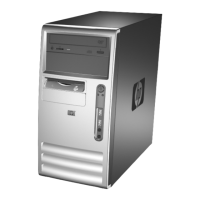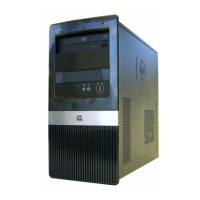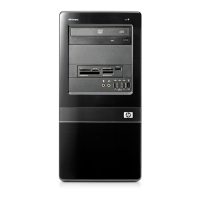Do you have a question about the HP Compaq dx6100 Series and is the answer not in the manual?
| Processor Speed | Up to 3.8 GHz |
|---|---|
| Chipset | Intel 915G |
| Processors | Intel Pentium 4 |
| RAM | Up to 4 GB DDR |
| Storage | Up to 160 GB HDD |
| Optical Drive | DVD-ROM |
| Graphics | Integrated Intel Graphics Media Accelerator 900 |
| Audio | Integrated audio |
| Network Interface | Integrated Ethernet |
| Expansion Slots | 3 PCI |
| Ports | USB 2.0, serial, parallel |
| Operating System | Microsoft Windows XP Professional |
Provides technical information about HP Compaq dc7100 and dx6100 series personal computers.
Lists manufacturers' documentation available at online sources for further information.
Explains the model numbering convention for HP systems.
Describes the location and method to read the unit's serial number.
Details the notational guidelines used throughout the guide.
Lists common acronyms and abbreviations used in the guide.
Introduces the HP Compaq dc7100 and dx6100 series business desktop computers.
Describes the standard features and options available for the systems.
Covers the six form factors and describes their mechanical aspects.
Details the system architecture based on the Intel Pentium 4 processor and 915G chipset.
Lists environmental, electrical, and physical specifications for the systems.
Introduces the processor/memory subsystem, featuring Intel Pentium 4 and 915G chipset.
Describes the Intel Pentium 4 processor, its architecture, and features.
Details the DDR memory architecture, DIMM sockets, and memory parameters.
Covers basic system architecture and related topics like PCI bus and system resources.
Describes the PCI bus, its implementation, and types of PCI buses used.
Explains availability and control of subsystems via interrupts and DMA requests.
Details the RTC and CMOS functions, battery backup, and clearing CMOS.
Covers functions related to security, power management, temperature, and overall status.
Provides system I/O map and information on general-purpose functions of ICH6.
Describes standard system board interfaces for input and output porting.
Details legacy EIDE (PATA) and Serial ATA (SATA) interfaces.
Explains the diskette drive interface function integrated into the LPC47B397 I/O controller.
Describes the RS-232-C serial interface and its programming.
Details the parallel interface for peripheral connection and its modes.
Explains the keyboard and pointing device interface function provided by the LPC47B397.
Describes the USB interface, its ports, and data transfer rates.
Details the AC97 Audio Controller and AD1981B Audio Codec functionality.
Describes the 10/100/1000 Mbps network support via Broadcom BCM5751 NIC.
Introduces the integrated graphics subsystem within the 82915G/GV GMCH component.
Details the Intel 915G/GV GMCH component's integrated graphics controller (IGC) functions.
Covers supported display modes for 2D and 3D video displays.
Explains how to upgrade graphics by installing cards into PCI Express or PCI 2.3 slots.
Describes the standard VGA connector for attaching an analog monitor.
Describes power supply and general power and signal distribution methods.
Details the power supply assembly and its control via programmable logic.
Explains the distribution of 3.3/5/12 VDC and low voltage power.
Illustrates general signal distribution between main system subassemblies.
Defines BIOS as firmware for machine language programs, covering POST, PnP, and Setup.
Explains BIOS firmware re-writing for upgrading and splash screen changes.
Covers BIOS functions related to the boot process, including device order and network boot.
Allows configuration of system functions like security, power management, and resources.
Lists BIOS functions supporting intelligent manageability applications.
Details Plug 'n Play (PnP) support for PnP version 1.0A.
Explains BIOS ROM check for USB keyboard during POST for setup.
Lists error codes and probable causes for system errors.
Provides beep and LED indications for system boot and ROM flash status.
Lists POST messages and their probable causes.
Details system error messages and their probable causes.
Lists memory-related error messages and their probable causes.
Provides a list of keyboard error messages and their probable causes.
Lists printer error messages and their probable causes.
Details video and graphics error messages and their probable causes.
Lists diskette drive error messages and their probable causes.
Provides serial interface error messages and their probable causes.
Lists modem communication error messages and their probable causes.
Details system status error messages and their probable causes.
Lists hard drive error messages and their probable causes.
Provides hard drive error messages and their probable causes.
Lists video and graphics error messages and their probable causes.
Details audio subsystem internal error messages.
Lists DVD/CD-ROM error messages and their probable causes.
Provides network interface error messages and their probable causes.
Lists SCSI interface error messages and their probable causes.
Details pointing device error messages and their probable causes.
Lists the 256-character ASCII code set, including decimal and hexadecimal values.
Describes the HP keyboard, its compliance, and features.
Explains the keystroke processing elements and PS/2 transmission.
Describes the PS/2-type and USB-type keyboard interface connectors and pinouts.












